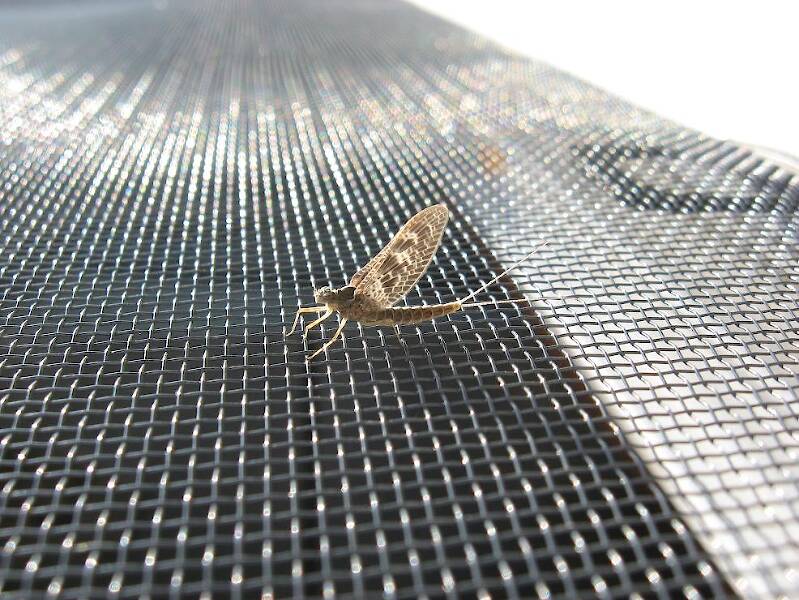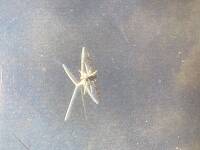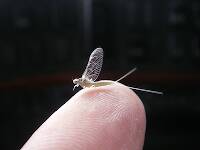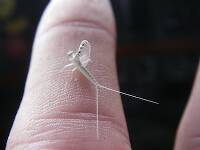
Hex Mayflies
Hexagenia limbata
The famous nocturnal Hex hatch of the Midwest (and a few other lucky locations) stirs to the surface mythically large brown trout that only touch streamers for the rest of the year.
Featured on the forum

This one was surprisingly straightforward to identify. The lack of a sclerite at the base of the lateral hump narrows the field quite a bit, and the other options followed fairly obvious characteristics to Clostoeca, which only has one species, Clostoeca disjuncta.

Troutnut is a project started in 2003 by salmonid ecologist Jason "Troutnut" Neuswanger to help anglers and
fly tyers unabashedly embrace the entomological side of the sport. Learn more about Troutnut or
support the project for an enhanced experience here.

Shakeyfly on Apr 27, 2009April 27th, 2009, 11:43 am EDT
Hello all, I have been watching this sight closely for a while now, and Everyday I learn something new. Unfortunately, I can contribute very little!! but I happened to photograph a bug just now on the screen to my window. Can you please help me identify it? I thought it was a March Brown Dun (stenonema-vicarium), but possible a Quill Gordon(epeorus-pleuralis)? I got the latin names from Hatch Guide For New England Streams, but not sure which one it is!!
Thank you all for your help, I hope the picture posts nicely.
Thank you all for your help, I hope the picture posts nicely.
The fishing was good; it was the catching that was bad - A.K. Best
Catching fish is as incidental to fishing as making babies is to #$%&ing. ~William Humphrey
Here's to swimmin' with bow legged women. - Jaws
Catching fish is as incidental to fishing as making babies is to #$%&ing. ~William Humphrey
Here's to swimmin' with bow legged women. - Jaws
GONZO on Apr 27, 2009April 27th, 2009, 11:54 am EDT
Hi Shakey,
This is a female Callibaetis dun (probably C. f. ferrugineus). These distinctive members of Baetidae are usually most common in ponds and lakes, though some can be found in streams.
This is a female Callibaetis dun (probably C. f. ferrugineus). These distinctive members of Baetidae are usually most common in ponds and lakes, though some can be found in streams.
Shakeyfly on Apr 27, 2009April 27th, 2009, 1:19 pm EDT
Wow was I off!! I am checking out my book right now to see what fly I can match it too! Thanks!
The fishing was good; it was the catching that was bad - A.K. Best
Catching fish is as incidental to fishing as making babies is to #$%&ing. ~William Humphrey
Here's to swimmin' with bow legged women. - Jaws
Catching fish is as incidental to fishing as making babies is to #$%&ing. ~William Humphrey
Here's to swimmin' with bow legged women. - Jaws
Shakeyfly on Apr 27, 2009April 27th, 2009, 2:17 pm EDT
It's weird because this new england hatch guide doesn't mention Callibaetus or speckled duns
The fishing was good; it was the catching that was bad - A.K. Best
Catching fish is as incidental to fishing as making babies is to #$%&ing. ~William Humphrey
Here's to swimmin' with bow legged women. - Jaws
Catching fish is as incidental to fishing as making babies is to #$%&ing. ~William Humphrey
Here's to swimmin' with bow legged women. - Jaws
GONZO on Apr 27, 2009April 27th, 2009, 2:43 pm EDT
Yeah, unless you have a coldwater trout pond or lake nearby, they're not very important. (And Ames' book is a guide to New England streams.) Callibaetis species get a lot of attention on Western trout lakes, but they often tend to be ignored in the East.
Taxon on Apr 27, 2009April 27th, 2009, 2:45 pm EDT
Shakefly-
That's because most hatch guides are for streams, and as Gonzo indicated, only in lakes are Callibaetis generally present in sufficient number to interest trout.
That's because most hatch guides are for streams, and as Gonzo indicated, only in lakes are Callibaetis generally present in sufficient number to interest trout.
Shakeyfly on Apr 27, 2009April 27th, 2009, 2:45 pm EDT
oooo That makes sense. I do not have a lake really close by... maybe about 2 miles away, but it was just interesting that a lot of people focus on them in the west but not in the east.
The fishing was good; it was the catching that was bad - A.K. Best
Catching fish is as incidental to fishing as making babies is to #$%&ing. ~William Humphrey
Here's to swimmin' with bow legged women. - Jaws
Catching fish is as incidental to fishing as making babies is to #$%&ing. ~William Humphrey
Here's to swimmin' with bow legged women. - Jaws
Shakeyfly on Apr 27, 2009April 27th, 2009, 2:53 pm EDT
Thanks guys!! I am new to the entomology of our favorite passtime. I am learning tons!! Thank you!
The fishing was good; it was the catching that was bad - A.K. Best
Catching fish is as incidental to fishing as making babies is to #$%&ing. ~William Humphrey
Here's to swimmin' with bow legged women. - Jaws
Catching fish is as incidental to fishing as making babies is to #$%&ing. ~William Humphrey
Here's to swimmin' with bow legged women. - Jaws
Taxon on Apr 27, 2009April 27th, 2009, 6:16 pm EDT
Shakeyfly-
Perhaps I should have said still water, like even a neighbor's goldfish pond, etc.
I do not have a lake really close by... maybe about 2 miles away
Perhaps I should have said still water, like even a neighbor's goldfish pond, etc.
Troutnut on Apr 27, 2009April 27th, 2009, 10:30 pm EDT
Welcome to the site, Shakeyfly.
I don't have much to add about your mayfly; the others covered it well. But I did want to comment on a general way of thinking about books like the Hatch Guide. A lot of people seem to refer to them to look up a mayfly, then get baffled when it doesn't quite look like anything in the book.
The Hatch Guide is a really impressive book, but it's not a comprehensive field guide to every bug you might find. It covers the main hatches that provide good hatch-matching fishing in the region. Go to a gas station by a trout stream on any given night, though, and you'll find the lights have probably attracted at least a dozen mayfly, stonefly, and caddisfly species that aren't in the book. There are hundreds of obscure species throughout the year that aren't worth mentioning individually in such a book, but combined they make up a decent proportion of any stream's hatches.
The message is that you can rely on a book like that to identify the selected common insects it includes, but a fly's seeming absence from the book doesn't mean you've made a mistake... it's probably just not in there, and you should post it here.
VERY nice artistic photo on this one, by the way!
I don't have much to add about your mayfly; the others covered it well. But I did want to comment on a general way of thinking about books like the Hatch Guide. A lot of people seem to refer to them to look up a mayfly, then get baffled when it doesn't quite look like anything in the book.
The Hatch Guide is a really impressive book, but it's not a comprehensive field guide to every bug you might find. It covers the main hatches that provide good hatch-matching fishing in the region. Go to a gas station by a trout stream on any given night, though, and you'll find the lights have probably attracted at least a dozen mayfly, stonefly, and caddisfly species that aren't in the book. There are hundreds of obscure species throughout the year that aren't worth mentioning individually in such a book, but combined they make up a decent proportion of any stream's hatches.
The message is that you can rely on a book like that to identify the selected common insects it includes, but a fly's seeming absence from the book doesn't mean you've made a mistake... it's probably just not in there, and you should post it here.
VERY nice artistic photo on this one, by the way!
Jason Neuswanger, Ph.D.
Troutnut and salmonid ecologist
Troutnut and salmonid ecologist
Shakeyfly on Apr 28, 2009April 28th, 2009, 4:09 am EDT
I am definitely learning that the guide is exactly what it is... a guide! Not a tell all book!
I wanted to say how impressive this site trully is. The pictures and people on it are amazing!!
I found that little Callibaetis on my window screen. I am not a photographer by any means, so I changed the setting to Flowers, focused in close, and clicked! It's now my desktop background!
The interesting thing about this bug, was how little it moved. It let me touch it and everything without moving! I think it was trying to dry it's wings maybe?
I wanted to say how impressive this site trully is. The pictures and people on it are amazing!!
I found that little Callibaetis on my window screen. I am not a photographer by any means, so I changed the setting to Flowers, focused in close, and clicked! It's now my desktop background!
The interesting thing about this bug, was how little it moved. It let me touch it and everything without moving! I think it was trying to dry it's wings maybe?
The fishing was good; it was the catching that was bad - A.K. Best
Catching fish is as incidental to fishing as making babies is to #$%&ing. ~William Humphrey
Here's to swimmin' with bow legged women. - Jaws
Catching fish is as incidental to fishing as making babies is to #$%&ing. ~William Humphrey
Here's to swimmin' with bow legged women. - Jaws
Quick Reply
Related Discussions
Topic
Replies
Last Reply
1
Jan 8, 2015
by Wbranch
by Wbranch
1
Jan 15, 2018
by Millcreek
by Millcreek
3
Jun 17, 2017
by JohnR
by JohnR
10
Jul 27, 2008
by Phillyfired
by Phillyfired
8
Jan 7, 2009
by Dgracia
by Dgracia







